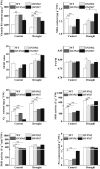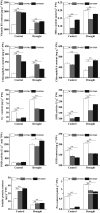MsTHI1 overexpression improves drought tolerance in transgenic alfalfa (Medicago sativa L.)
- PMID: 36160983
- PMCID: PMC9495609
- DOI: 10.3389/fpls.2022.992024
MsTHI1 overexpression improves drought tolerance in transgenic alfalfa (Medicago sativa L.)
Abstract
In recent years, drought stress caused by global warming has become a major constraint on agriculture. The thiamine thiazole synthase (THI1) is responsible for controlling thiamine production in plants displaying a response to various abiotic stresses. Nonetheless, most of the THI1 activities in plants remain largely unknown. In this study, we extracted MsTHI1 from alfalfa and demonstrated its beneficial impact on improving the resistance of plants to stress conditions. The highest levels of MsTHI1 expression were identified in alfalfa leaves, triggered by exposure to cold, drought, salt, or alkaline conditions. The upregulation of MsTHI1 in drought-stressed transgenic plants resulted in enhanced accumulation of vitamin B1 (VB1), chlorophyll a (Chl a), chlorophyll b (Chl b), soluble protein, higher soil and plant analyzer development (SPAD) value, and the activity of peroxidase (POD), maintained Fv/Fm, and decreased lipid peroxidation. Moreover, overexpression of MsTHI1 upregulated the transcription of THI4, TPK1, RbcX2, Cu/Zn-SOD, CPK13, and CPK32 and downregulated the transcription of TH1 and CPK17 in transgenic alfalfa under drought stress. These results suggested that MsTHI1 enhances drought tolerance by strengthening photosynthesis, regulating the antioxidant defense system, maintaining osmotic homeostasis, and mediating plant signal transduction.
Keywords: MsTHI1; alfalfa; antioxidant defense; drought tolerance; osmotic homeostasis; photosynthesis.
Copyright © 2022 Yin, Wang, Li, Zhang, Yang, Cui and Zhang.
Conflict of interest statement
The authors declare that the research was conducted in the absence of any commercial or financial relationships that could be construed as a potential conflict of interest.
Figures







Similar articles
-
MsFtsH8 Enhances the Tolerance of PEG-Simulated Drought Stress by Boosting Antioxidant Capacity in Medicago sativa L.Plants (Basel). 2024 Oct 29;13(21):3025. doi: 10.3390/plants13213025. Plants (Basel). 2024. PMID: 39519944 Free PMC article.
-
Overexpression of GsZFP1 enhances salt and drought tolerance in transgenic alfalfa (Medicago sativa L.).Plant Physiol Biochem. 2013 Oct;71:22-30. doi: 10.1016/j.plaphy.2013.06.024. Epub 2013 Jul 3. Plant Physiol Biochem. 2013. PMID: 23867600
-
Co-transforming bar and CsLEA enhanced tolerance to drought and salt stress in transgenic alfalfa (Medicago sativa L.).Biochem Biophys Res Commun. 2016 Mar 25;472(1):75-82. doi: 10.1016/j.bbrc.2016.02.067. Epub 2016 Feb 21. Biochem Biophys Res Commun. 2016. PMID: 26906624
-
Drought tolerance in alfalfa (Medicago sativa L.) varieties is associated with enhanced antioxidative protection and declined lipid peroxidation.J Plant Physiol. 2019 Jan;232:226-240. doi: 10.1016/j.jplph.2018.10.023. Epub 2018 Oct 31. J Plant Physiol. 2019. PMID: 30537610
-
Research on drought stress in Medicago sativa L. from 1998 to 2023: a bibliometric analysis.Front Plant Sci. 2024 May 30;15:1406256. doi: 10.3389/fpls.2024.1406256. eCollection 2024. Front Plant Sci. 2024. PMID: 38872890 Free PMC article. Review.
Cited by
-
Genome-wide investigation of the PIF gene family in alfalfa (Medicago sativa L.) expression profiles during development and stress.BMC Genom Data. 2024 Sep 2;25(1):79. doi: 10.1186/s12863-024-01264-4. BMC Genom Data. 2024. PMID: 39223486 Free PMC article.
-
Advances in basic biology of alfalfa (Medicago sativa L.): a comprehensive overview.Hortic Res. 2025 Mar 10;12(7):uhaf081. doi: 10.1093/hr/uhaf081. eCollection 2025 Jul. Hortic Res. 2025. PMID: 40343348 Free PMC article.
-
MsSPL12 is a positive regulator in alfalfa (Medicago sativa L.) salt tolerance.Plant Cell Rep. 2024 Mar 18;43(4):101. doi: 10.1007/s00299-024-03175-1. Plant Cell Rep. 2024. PMID: 38498195
-
Transcriptomic analysis of melatonin-mediated drought stress response genes in alfalfa during germination period.BMC Plant Biol. 2025 May 14;25(1):637. doi: 10.1186/s12870-025-06665-w. BMC Plant Biol. 2025. PMID: 40369428 Free PMC article.
-
The quest for molecular markers indicating root growth in microbially treated tomato (Solanum lycopersicum) plants.FEMS Microbiol Ecol. 2025 Jun 24;101(7):fiaf063. doi: 10.1093/femsec/fiaf063. FEMS Microbiol Ecol. 2025. PMID: 40569659 Free PMC article.
References
-
- Abidin A. A. Z., Yee W. S., Rahman N. S. A., Idris Z. H. C., Yusof Z. N. B. (2016). Osmotic, oxidative and salinity stresses upregulate the expressions of Thiamine (vitamin B1) biosynthesis genes (THIC and THI1/THI4) in oil palm (Elaeis guineensis). J. Oil Palm Res. 28, 308–319. 10.21894/jopr.2016.2803.07 - DOI
-
- Amjad S. F., Mansoora N., Yaseen S., Kamal A., Butt B., Matloob H., et al. . (2021). Combined use of endophytic bacteria and pre-sowing treatment of thiamine mitigates the adverse effects of drought stress in wheat (Triticum aestivum L.) Cultivars. Sustainability 13, 6582. 10.3390/su13126582 - DOI
LinkOut - more resources
Full Text Sources

